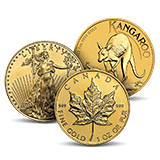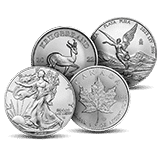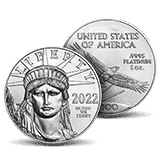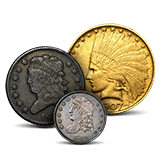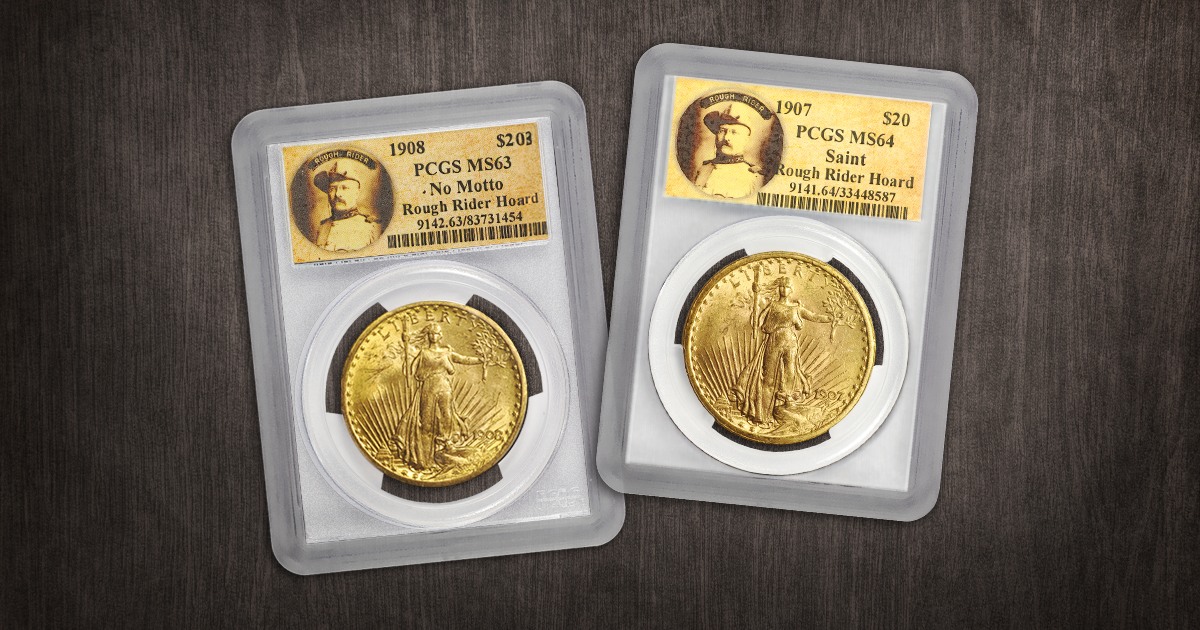
The Rough Rider coin hoard is a Mint State group of 1907 and 1908 Saint Gaudens $20 Gold Double Eagles steeped in history and rediscovered under mysterious circumstances.
The Roosevelt Era and the Coinage Renaissance
At the dawn of the 20th century, President Theodore Roosevelt launched a mission to bring American coinage to the level of fine art to reflect the nation’s ideals and grandeur. To that end, he enlisted sculptor Augustus Saint-Gaudens for a redesign of America’s gold coinage.
Saint-Gaudens’ masterpiece, the $20 Double Eagle, debuted in 1907. Due to Roosevelt’s philosophical stance, the coin was struck without the motto “IN GOD WE TRUST.” The coin quickly became a symbol of artistic rebirth and controversy. Negative responses from the public resulted in Congress reinstating the motto in 1908. Nearly 5,000,000 No Motto 1908 Gold $20 Double Eagles were struck before IN GOD WE TRUST was reinstated.
Discovery of the Hoard
The Rough Rider Hoard was found in the vaults of the Union Bank of Switzerland (UBS) in Zurich in the early 2000s. A team of numismatists and coin dealers made the discovery.
The hoard held nearly two thousand untouched $20 Saint-Gaudens Gold Double Eagles. The coins had been stored in a bank vault and avoided circulation, preserving the original mint luster and sharp details. The hoard was shrouded in secrecy surrounding its origin, adding to its intrigue and appeal.
Historical Context and Journey to Europe
The journey of the Rough Rider Hoard to Europe can be attributed to several factors. During the late 19th and early 20th centuries, pre-1933 American gold coins like the Saint-Gaudens Double Eagles were widely used in international trade. This use of gold coins in international trade meant that American gold coins frequently crossed borders. Transactions involving commodities, financial services, and diplomatic exchanges often resulted in the movement of gold coins to European financial institutions.
Additionally, private holdings and investments by wealthy individuals and entities contributed to the presence of American gold coins in Europe. These coins were seen as a secure and valuable asset, leading to their storage in European banks and private vaults.
Storage and Preservation
Once in Europe, the coins were meticulously stored in secure vaults of banks known for their stringent security measures. UBS, in particular, was renowned for its discretion and reliability, making it a favored destination for storing valuable assets. The pristine condition of the Rough Rider Hoard suggests that the coins were kept in environments that protected them from environmental damage, ensuring their preservation over the decades.
Authentication, Grading & Provenance
The discovery of the Rough Rider Hoard marked a significant event in the numismatic world. The coins were authenticated and graded by the Professional Coin Grading Service (PCGS), confirming their exceptional condition and historical value. The coins received mint-state grades ranging from MS-61 to MS-66. Each certified coin was encapsulated with a custom label: “Rough Rider Hoard”, establishing permanent provenance.
In numismatics, provenance is not just a curiosity, it can be a value driver. Collectors place a premium on coins with documented histories, especially when tied to significant finds. The return of these coins to the U.S. numismatic market was facilitated by firms like Monaco Rare Coins, which played a crucial role in marketing and selling the hoard.
Contents of the Hoard
The hoard featured two primary types:
- 1907 Saint-Gaudens $20 Double Eagles (No Motto)
- 1908 Saint-Gaudens $20 Double Eagles (No Motto)
These “No Motto” coins are historically significant for their short mintage and symbolic ties to Roosevelt’s reformist vision.
Valuation and Market Impact
Once certified and released, the Rough Rider coins entered the market at values reflecting their rarity, condition, and historical context:
The hoard’s release sparked renewed interest in early Saint-Gaudens coins. Investors saw them as portfolio hedges with historical appeal, while collectors prized the chance to own pieces with unique provenance. The value of Saint-Gaudens Gold Double Eagles ranges from about $3,000 in MS-61 to $53,000 in MS-66 grades.
Who Were the Rough Riders?
The hoard’s name pays homage to Roosevelt’s famed volunteer cavalry unit, the Rough Riders, who fought in the Spanish-American War. The name evokes rugged patriotism, boldness, and a turn-of-the-century spirit that aligns with the coinage’s era.
The Rough Rider Hoard checks every box:
- Historical relevance: Directly tied to Roosevelt’s golden age of coinage reform.
- Artistic beauty: Among the most admired U.S. coin designs ever minted.
- Investment appeal: Gold content + PCGS certification + limited provenance.
- Mystery and legacy: A storybook origin wrapped in patriotic symbolism.
The Rough Rider coin hoard is a link between past and present, between Roosevelt’s vision and today’s numismatic world. For collectors and investors alike, it represents a rare convergence of history, artistry, and value.

